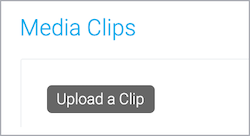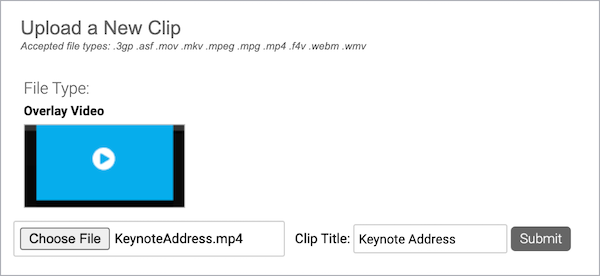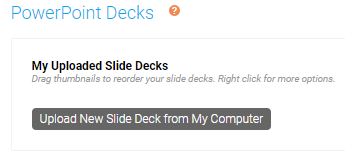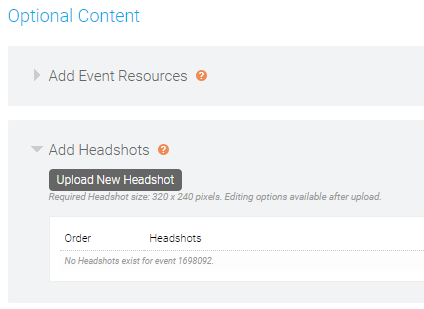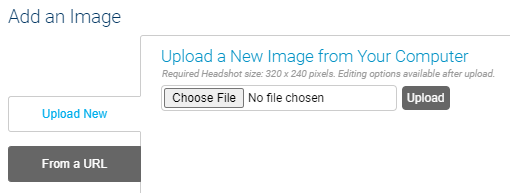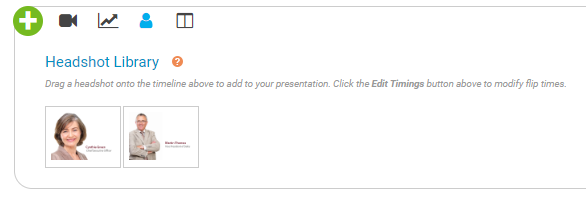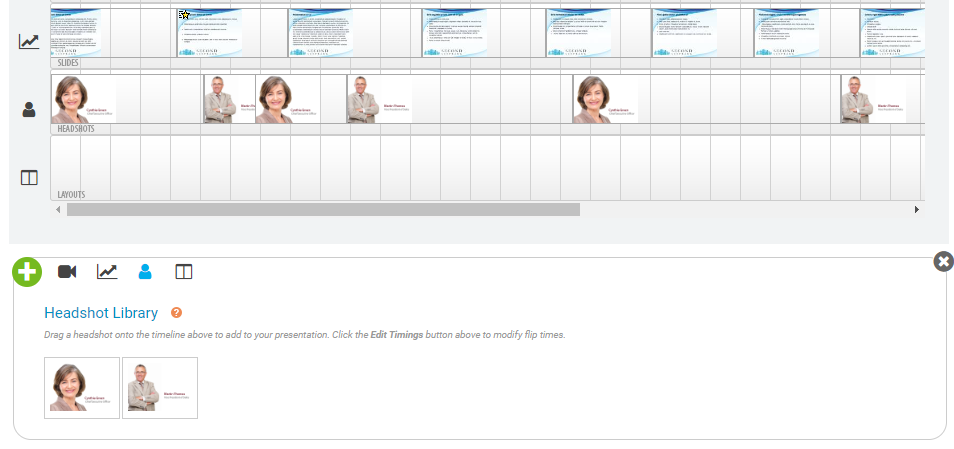Event Content
- About Q&A
- Add a third-party video to a custom tab
- Add third-party tools to an event
- How do I create a certificate?
- Overlay video specs and requirements
- PowerPoint Best Practices
- Primary media clip specs and requirements
- Remove embedded fonts from slides
- Supported 3rd party tools
- Upload audio clips for use in a recorded event
- Upload videos for use in a recorded event
- Upload videos to play in a Live event
- Upload Slides to an Event
- Add headshots to an audio event
- Add content download or external links
About Q&A
Allow attendees to submit questions during a Live, Simulated Live, or On-Demand event or through an attendee portal.
For Live events, Simulated Live events and attendee portals, you can use the Q&A queue to answer questions, prioritize questions to decide which ones you'll answer first, edit answers, and delete questions you won't answer. You can also assign questions to specific presenters or groups by creating additional tabs and assigning questions to them from the New Questions tab. The Q&A queue refreshes automatically as questions are submitted and answered. Questions are hidden from the audience until they're answered.
The numbers next to questions show the order in which they were asked. Use the tabs to monitor new questions as they arrive or to view lists of questions that were answered, deleted, or revoked (sent back to be answered again). Click any of the column headers to sort the questions.
At the top right of the Q&A queue are additional options. You can manually refresh the queue, open it in a new window (from the Live Studio), add new questions to the queue, save the list of questions from the tab you're on as a CSV file, and print them.
For On-Demand events, you can have questions sent to specific email addresses and reply to the email to answer the question. You can also optionally have questions sent by email for Live events.
After the event, run an Event Analytics report and select Q&A to view all submitted questions, the attendees who asked the questions, and presenter answers.
Add a third-party video to a custom tab
Enhance your events by including videos that viewers can play at any time. You can include YouTube, Vimeo, or Brightcove videos. During the event, the videos display in tabs on the right side of the event window, next to the video stream or headshots. The videos play in the tab instead of in an overlay window.
Example Code
Use the following sample code to embed your video. Replace INSERT YOUR LINK HERE with the link found in the video player's embed code.
<!DOCTYPE html>
<html>
<head>
<title></title>
</head>
<body style="min-height: 405px;">
<iframe style="position:absolute;top:0;left:0;border:none;" scrolling="no" width="640" height="360" src="INSERT YOUR LINK HERE" frameborder="0" allowfullscreen="">
</body>
</html>
This is an example of a YouTube video's embed code and link. Only copy the URL.
<iframe width="560" height="315" src="https://www.youtube.com/embed/7s5qAuUZexw" title="YouTube video player" frameborder="0" allow="accelerometer; autoplay; clipboard-write; encrypted-media; gyroscope; picture-in-picture" allowfullscreen></iframe>
Add videos to your event
To add a video in a custom tab:
- Sign in to the Webcast Admin portal and edit the event.
- On the left panel, click the Event Content tab.
- Under Optional Content, expand the Add Custom Player Tabs section and click Add Primary Tab.
- In the Manage Tab Content window, enter a name for the tab.
- At the top right side of the text editor, click </> to switch to code view.
- Delete all the placeholder code.
- Copy the example code and paste it into the editor. Replace INSERT YOUR LINK HERE with your video link.
Note: For the video to work properly, the link must begin with https:// and contain one of the following expected domains: players.brightcove.net, vimeo.com, player.vimeo.com, youtube.com, youtu.be.
- Click Save Changes to save the coding. Then click Save and Continue to save changes to the event content.
Add third-party tools to an event
Enhance your events by including interactive tools like captioning, polling, surveys, real-time Q&A, and more. Add a custom player tab to your event and use the embed code from third-party apps and platforms. During the event, the tools display in tabs on the right side of the event window, next to the video stream or headshots.
Note: This requires that you have an account with the app or platform that provides the polls, real-time Q&A, surveys, or other interactive tools that you want to incorporate in your event. For more information, see Supported third-party tools.
Support is not able to set up, test, or manage third-party tools for self-service clients. If you would like someone to manage an end-to-end integration, please contact your sales representative to arrange a consulting package.
Jump to: Example Code | Add Third-party Tools
Example code
Use the following sample code to embed your third-party tool. Replace INSERT YOUR LINK HERE with the link found in your tool's embed code.
<!DOCTYPE html> <html> <head> <title></title> </head> <body style="min-height: 405px;"> <iframe style="position:absolute;top:0;left:0;height: 100%; border: none;width:100%;" scrolling="no" src="INSERT YOUR LINK HERE" frameborder="0"></iframe> </body> </html>
This is an example of Conferences i/o's embed code and link. Only copy the URL.
<iframe src="https://help.cnf.io/sessions/mkta/#!/polls/cr6s" style="width: 100%; max-width: 400px; height: 600px;"> </iframe>
Add third-party tools to your event
To set up a third-party tool, find and copy the embed code from the app or platform and then paste it into a custom tab. Before the event, view the event and make sure the third-party tool works properly.
The webcast player does not interact or control the third-party tool or content. It uses the embed code provided by the vendor to retrieve the component you want to incorporate. For security reasons, the webcast player only connects to specific, "expected" domains for each tool. See Supported third-party tools for a list of tools and the expected domains.
To embed a third-party tool:
- Sign in to the Webcast Admin portal and edit the event.
- On the left panel, click the Event Content tab.
- Under Optional Content, expand the Add Custom Player Tabs section and click Add Primary Tab.
- In the Manage Tab Content window, enter a name for the tab.
- At the top right side of the text editor, click </> to switch to code view.
- Delete all the placeholder code.
- Copy the example code and paste it into the editor. Replace INSERT YOUR LINK HERE with the link found in your tool's embed code.
Note: For the third-party tool to work properly, the link must begin with https:// and the domain expected for the service.
- Click Save Changes to save the coding. Then click Save and Continue to save changes to the event content.
How do I create a certificate?
The system requires a .PDF file be uploaded, which will serve as the template that is customized and distributed to viewers that meet the certification requirements for your event. The PDF requires Forms be included to populate the viewer's name (First Name and Last Name fields need to be required on the Registration Form), the certificate title, the date the certificate was received and a unique certificate ID. These Forms need to be setup in using Adobe Acrobat and use the following formatting:
- __TITLE__ to populate the title entered in the Name of Certificate field.
- Note: If the Certification Method is set to Viewing Duration, the title of the event on the certificate is limited to 50 characters. Please use an abbreviated title if needed.
- __NAME__ to populate the viewer's name. First and Last Name registration fields should be required on the Registration Form.
- __DATE__ to populate the date the certificate was received.
- __CERTID__ to populate a unique Certificate ID.
If you do not want to populate the Name, Date, Title and/or Certificate ID fields on each certificate, the forms can be set to invisible or the text can be set to match the certificate's background color, but forms are required.
Select the Download Sample PDF button in the setup for an example of how your certificate needs to be setup.
Overlay video specs and requirements
For Live, On-Demand, and Simulated Live events.
You can upload as many as 10 overlay videos to your event and share them with the audience. For Live events, you are limited to 10 videos whether you launch them inline or in overlay windows. For On-Demand and Simulated Live this limit is for overlay videos only.
We support all video resolutions and many file formats, but all videos are transcoded to MP4 for use in the event.
The bit rate videos are transcoded to depends on the original video bit rate. Videos that are:
- Above 1700 kbps are transcoded at 1700 kbps
- Between 800 to 1700 kbps are transcoded at the uploaded bit rate
- Below 800 kbps are transcoded at 800 kbps
Recommended specs
For the best video quality, upload videos that meet these recommended specs:
- File format: MP4
- Video codec: H264
- Video bit rate: 800 kbps
- Aspect ratio: 16:9 widescreen
- Audio codec: AAC
- Audio bit rate: 96 kbps/48 khz mono
Requirements
- Maximum 10 overlay videos per event
- Maximum 10 GB per video
- Supported file formats: 3GP, ASF, F4V, MKV, MOV, MP4, MPEG, MPG, WEBM, and WMV
- Must be at least 15 seconds long.
- Must include an audio track; the audio track can be silent, but videos without an audio track will not process successfully.
Additional notes
- Each video can be up to 10 GB. We recommend using a high-speed wired internet connection to avoid time-outs.
You could also transcode the file to a smaller file size or bit rate before uploading to improve the upload and processing time.
- Overlay videos are displayed at the native size of the file, but will stream to the audience at a maximum of 896 kbps.
You can upload videos of any resolution (for example, 1080p), but higher resolution videos may stream at a lower quality than you'd see on your computer. Before the event, review the quality of the uploaded video to make sure it meets your standards. For more information, see Share a video during a Live event.
PowerPoint Best Practices
General Best Practices
PowerPoint slides need to be uploaded in advance. Final slides should be uploaded at least 4 hours before your event, but we recommend uploading 24 hours in advance to ensure there is adequate time for processing and review.
Some advanced PowerPoint features are not recommended for use in your presentation. To optimize your slide decks for your Webcast presentation, please use the following as a guideline:
- Use PowerPoint 2007 or later to create your slides
- Save as a .PPT or .PPTX file
- Files are limited to 500 MB in size and 200 slides per deck.
- For Slide Size, use Standard (4:3) or Widescreen (16:9).
- Custom-sized slides will be converted, which may cause the content to be reformatted.
- Remove any "Read-Only" Restriction before uploading the file.
- Remove embedded fonts being used in the slide deck. See below for detailed instructions.
- Remove any password protection from your presentation before uploading the file to ensure the slides can be processed.
- Any security that is required for your presentation can be handled through a variety of other options.
- Do not embed or insert audio or video clips into your PowerPoint presentation.
- Since the platform allows you to speak to the slides in real-time as you present them, any audio clips embedded into your presentation will interfere with your viewers' ability to hear what you are saying on the presentation. Video clips can be added to your presentation as an Overlay video, ensuring that it is optimally displayed to your viewers. Gifs are not officially supported but may work. If your deck includes gifs, please review the slides after uploaded to confirm if the gifs processed correctly.
- When inserting objects into your presentation:
- Make sure to leave the Link box unchecked.
- Make sure that you are set to Insert (Not Link to File or Insert and Link).
- Do not link to external images or spreadsheets.
- Do not use tables created from versions of Excel older than Excel 2007
- Slides should be numbered starting at Slide 1.
- Decks numbered starting at Slide 0 will automatically be renumbered.
- Ungroup any SmartArt objects that may be grouped together. This will ensure that each object is processed and displayed correctly on the presentation.
- Try to keep the background one color and avoid fading or transitional backgrounds. These types of backgrounds do not always convert well and can become pixilated.
- Try to use graphics and backgrounds that use the RGB color palate. Graphics that use the RGB color palette will be displayed as you see them on the screen. The alternative is CMYK, which is used for printing graphics and may appear differently when converted.
- Make sure that the content of your slides is set to use only the defined slide area and does not run off the slide. This will ensure that it displays properly once it is converted.
- By default, the slide processors will always use the first Slide Master. Update the Slide Master order and remove any unused Slide Masters. This will ensure slides display properly once it is converted.
- If you encounter display or formatting issues with an uploaded slide deck, check "Process as Images (No animations)" below the PowerPoint Decks upload to convert the slides to static images. This option maintains the look of the slides but removes any animations included in the slide deck.
PowerPoint Fonts
- Font Size: Your font size should be at least 12 point or higher. Anything smaller could be difficult for the audience to read, even on full screen slides. Fonts must not contain a decimal place. Any decimals will be rounded up to the next whole number.
- Supported Fonts: A list of supported fonts can be accessed here: https://www.microsoft.com/typography/fonts/product.aspx?PID=157
- Custom Fonts: Custom fonts are allowed, but should only be used as necessary. If a custom font is required, please provide the font file(s) in .otf or .ttf format to your Production Manager (for managed events) or Support (for self-service events). Font files should be provided at least 24-hours before the start of the event and will require the PowerPoint presentation to be re-uploaded after the custom fonts have been installed.
- Licensed Fonts: Licensed fonts are not supported by our system. Please change them to another font or remove the license restriction before uploading the presentation.
PowerPoint Animations & Transitions
Most standard PowerPoint Animations are supported with the following exceptions :
- Emphasis Effects:
- Bold Flash
- Underline
- Grow with Color
- Style Emphasis
- Entrance Effects:
- Dissolve In
- Fly In
The platform does not support timed animations. Any animations should be set On Click. Please be sure to remove them from your presentation before uploading.
Most standard PowerPoint transitions are supported, with the following exceptions:
- Bold Reveal
- Box
- Cube
- Doors
- Morph
- Page Curl
- Ripple
Reducing the Size of PowerPoint Files
High resolution images in PPT slides can greatly increase the size of a PowerPoint file when they are embedded within a slide. Here is a quick way to compress the images and reduce the file size substantially, without causing noticeable loss in image quality.
- Open the PowerPoint file.
- From the File menu, select Save As. When the Save As dialog pops up, click Tools to the left of the Save button, and click Compress Pictures.
- Depending on the version of PowerPoint you are using, follow the remaining instructions below.
PowerPoint 2007
- You will receive a dialog box. Click the Options button.
- On the Compression Settings dialog box, select "Automatically perform basic compression on save" and Delete cropped areas of pictures. Choose E-mail (96 ppi) minimize document size for sharing and Click OK.
- On the Compress Pictures dialog box, click OK.
PowerPoint 2010 or 2016
- On the Compress Pictures dialog box, click Delete cropped areas of pictures. Choose E-mail (96 ppi): minimize document for sharing and click OK.
Compression should take just a few seconds, but for files with many images, it could take up to a minute or two to process. Once complete, save the modified file and upload it.
Using Non-PowerPoint Files
Convey requires a PowerPoint file to be uploaded to an event. If you are using another program to create your presentation, refer to the instructions below for exporting the file to PowerPoint:
Keynote (Mac)
- Open the presentation and select File > Export To.
- Choose PowerPoint in the list of export options.
- Click Next and enter a name for the presentation.
- To choose where to save the presentation, click the Where pop-up menu, choose a location, then click Export.
- Open a file in Acrobat.
- Click on the Export PDF tool in the right pane.
- Choose Microsoft PowerPoint as your export format.
- Click Export.
- Name the PowerPoint file and save it in a desired location.
Prezi
- From Edit Mode, select the Share icon from the top menu. Then select Download as a PDF.
- When is ready, you will be prompted to save your Prezi as a PDF file.
- After selecting Save PDF, you will be prompted to name the PDF and choose where to save it. On both Windows and Mac, the default folder is Downloads.
- Once created, refer to the instructions above for converting the PDF to PowerPoint.
Removing Embedded Fonts
PowerPoint slides will need to have embedded fonts removed before the slides are uploaded to an event. Follow the steps below to remove embedded fonts:
- Open the PowerPoint file locally and select Remove Restricted Fonts when prompted.
- Click File > Save As. When prompted to save the file, select Tools (next to the Save button) and choose Save Options in the drop down.
- Uncheck the Embed fonts in the file option under "Preserve fidelity when sharing this presentation".
If custom fonts are being used in the PowerPoint file and are already installed in the Webcast platform, the fonts will load correctly when the PowerPoint is uploaded to the platform. If the fonts are not already installed, the custom font will be converted to a similar font when the PowerPoint is uploaded. Contact Support to provide custom font files for use in your PowerPoint slides.
Last Minute Uploads
PowerPoint slides need to be uploaded in advance. Final slides should be uploaded at least 4 hours before your event, but we recommend uploading 24 hours in advance to ensure there is adequate time for processing and review.
If slides are uploaded after a user has joined the Live Studio, they will need to exit and re-enter the Live Studio to see the updated content. It is recommended to have all presenters manually re-enter the Live Studio once it is confirmed the new slides are available. If presenters do not re-enter the Live Studio after new slides are uploaded, they will see an error message when the "Start Webcast" button is clicked and be forced to refresh, which may impact the start of the event while presenters reconnect.
Primary media clip specs and requirements
You can upload as many media clips to your event as you like and include them in your On-Demand or Simulated Live event. For events broadcasting video, you can upload video clips. For events broadcasting by telephone, you can upload audio clips.
Recommended specs
For the best quality, upload clips that meet these recommended specs:
- File formats: MP4 (video clips), or M4A, MP3, and WAV (audio clips)
- Video codec: H264
- Video bit rate:
- 480p: 800 kbps
- 720p: 1700 kbps
- 1080p: 3000 kbps
- Audio codec: AAC
- Audio bit rate: 96 kbps/48 khz mono
Requirements
- Maximum 10 GB per clip
- Supported audio file formats: M4A, MP3, and WAV
- Supported video file formats: 3GP, ASF, F4V, MKV, MOV, MP4, MPEG, MPG, WEBM, and WMV
- Clips must be at least 15 seconds long.
- Video clips must include an audio track; the audio track can be silent, but videos without an audio track will not process successfully.
Additional notes
- When you upload a video, it is transcoded to the appropriate bit rate and resolution based on the player size selected in the event setup. If you change the player size after uploading a video, you must upload the video again to have it transcoded for the new player size.
- Each clip can be up to 10 GB. We recommend using a high-speed wired internet connection to avoid time-outs. You could also transcode the file to a smaller file size or bit rate before uploading to improve the upload and processing time.
- You can upload videos of any resolution (for example, 1080p), but higher resolution videos may stream at a lower quality than you'd see on your computer. Before the event, review the quality of the uploaded video to make sure it meets your standards.
Remove embedded fonts from slides
Embedded fonts are not supported. Before uploading a slide deck to an event, you must remove embedded fonts from the deck.
Note: In total, we support over 1500 different font families. We probably already support your custom fonts or can add them for you. Contact Support for assistance.
To remove embedded fonts (Windows):
- Open the PowerPoint file on your computer.
- On the File menu, select Options and then in the left column, select the Save tab.
- At the bottom, under Preserve fidelity when sharing this presentation, clear the Embed fonts in the file check box.
- Save the file, then close and re-open it.
A different font is substituted for the font that had been embedded previously.
To remove embedded fonts (Mac):
- Open the PowerPoint file on your computer.
- On the PowerPoint application menu, click Preferences.
- Under Output and Sharing, click Save.
- Under Font Embedding, clear the Embed fonts in the file check box.
- Save the file, then close and re-open it.
A different font is substituted for the font that had been embedded previously.
Supported 3rd party tools
Enhance your events by including interactive elements with third-party apps and platforms. By default, polls, Q&A, and surveys are already included with your webcasting account, but you can use your own third-party tools to include these features, captions and interpretation, and more.
Note: You must have an account with the app or platform that you want to incorporate in your event.
We've tested and currently support the following third-party tools. Don't see the tool you'd like to use? Contact Support or your sales representative.
Jump to: Interactive Features | Captions, Interpretation, and Transcripts | Other Features
Interactive Features
| Third-party Tool | Features & Services | Expected Domains |
|---|---|---|
| Chatroll | Chat | chatroll.com |
| Conferences i/o | Polls Q&A |
cnf.io conferences.io |
| Kahoot | Brainstorms Leaderboards Polling Quizzes Surveys Word clouds |
kahoot.it |
| MeetingPulse | Brainstorms Downloadable Materials Photos Polls Q&A Quizzes Raffles Surveys |
meetingpulse.net meet.ps |
| Mentimeter | Polls Quizzes Q&A Surveys Word clouds |
mentimeter.com menti.com |
| Mural | Collaborative whiteboards | mural.co |
| Pigeonhole Live | Chat Polls Q&A Quizzes Reactions Registration Surveys |
pigeonhole.at |
| Poll Everywhere | Brainstorms Polls with clickable images, graphs, and maps Q&A Surveys Word clouds |
embed.polleverywhere.com pollev.com polleverywhere.com pollev-embeds.com |
| Prezi | Presentations Videos |
prezi.com |
| Remesh | Discussion guides with: Images Messages Polls Questions Videos |
remesh.chat |
| SCANTrivia | Icebreakers Leaderboards Trivia questions |
scanalytics.net scancode.mobi |
| Slido | Ideas Polls Q&A Quizzes Word clouds |
*.sli.do |
| SpatialChat | Interactive breakout rooms | spatial.chat |
| SurveyPlanet | Polls Surveys |
s.surveyplanet.com |
| Vevox | Polls Q&A Surveys Quizzes Word clouds |
vevox.app |
| Vpoll | Polls | app.vpoll.mobi |
Captions, Interpretation, and Transcripts
| Third-party Tool | Features & Services | Expected Domains |
|---|---|---|
| 3Play Media | Live automatic captions Live professional captions |
3playmedia.com |
| Ai-Live | Live professional captions | uk.ai-live.com au.ai-live.com |
| Captioned Text | Live professional captions Real-time transcripts |
captionedtext.com |
| Interactio | Live interpretation | app.interactio.io interactio.io |
| Interprefy | Live interpretation | interprefy.interpret.world interpret.world |
| KUDO | Live interpretation | *.kudoway.com |
| StreamText | Live professional captions | streamtext.net |
| Wordly | Live automatic captions | *.wordly.ai |
Other Features
| Third-party Tool | Features & Services | Expected Domains |
|---|---|---|
| Calendly | Calendar | calendly.com |
| Cvent | Automated email communications Payment collection Pre-registration questions |
cvent.com |
| Google Drive file embeds and links | google.com | |
| Jifflenow | Attendees can request meetings with Inbound Meetings Sync registration data |
jifflenow.com |
| Walls.io | Social media wall | walls.io |
Upload audio clips for use in a recorded event
For audio only broadcasts. To include pre-recorded audio in an On-Demand or Simulated Live event, upload audio files as primary event clips. Once uploaded, the clips can be added to the event in the editing studio. For more information, see Assemble or edit an event recording.
You can include up to 10 primary audio clips. Each clip can be up to 10 GB and must be at least 15 seconds long. Supported file types include: M4A, MP3, WAV
For more information about primary media clip requirements, see Primary Media Clip Specs and Requirements.
To upload a primary audio clip:
- Sign in to the Webcast Admin portal and edit the event.
- On the left panel, click the Event Content tab.
- Under Media Clips, click Upload a Clip.
- In the Upload a New Clip window, select Primary Event Clip as the file type, click Choose File, select the audio file, and then click Submit.
Note: The clip title is automatically generated based on the file name. You can optionally change the title before clicking Submit.
- After the clip has finished uploading, an Upload Successful message is displayed to let you know that the clip is being transcoded by the system. Click Ok.
The clip is displayed in the Primary Media Clips section with a processing status. Once the clip has finished processing, you can optionally change the title.
- Click Save and Continue to save changes to the event content.
Upload videos for use in a recorded event
To include videos in a recorded event, upload them to your event content. Then in the editing studio, add videos to the event timeline and publish the event. For more information, see Assemble or edit an event recording.
When you upload a video for a recorded event, you must designate where it will be played: upload it either as a Primary Media Clip or an Overlay Video. An Overlay Video plays on top of the audience event window and is designed to be supplementary content on an event (example - commercial or promotional video). A Primary Media Clip plays in the video player (where you see presenter webcams during a Live event) and is designed to be the primary content on an event.
Notes:
- Recorded events require at least one primary media clip. Overlay videos can’t be used as the sole event content.
- For audio only broadcasts, you can only upload videos as overlay videos. The video player is used to display presenter headshots and play audio clips. For more information, see Upload audio clips for use in a recorded event.
- Include as many overlay videos as you like and up to 10 primary clips. Each video can be up to 10 GB, must be at least 15 seconds long, and must include an audio track.
For more information about video requirements, see Overlay Video Specs and Requirements and Primary Media Clip Specs and Requirements.
Jump to: Upload a primary media clip | Upload an overlay video
Upload a primary media clip
To avoid distortion, upload primary media clips with the same aspect ratio as the video player (16:9 for video bridge broadcasts; 4:3 or 16:9 for webcam and encoder).
To add a primary media clip to an event:
- Sign in to the Webcast Admin portal and edit the event.
- On the left panel, click the Event Content tab.
- Under Media Clips, click Upload a Clip.
- In the Upload a New Clip window, select Primary Event Clip as the file type, click Choose File, select the clip, and then click Submit.
Note: The clip title is automatically generated based on the file name. You can change the title before clicking Submit.
- After the clip has finished uploading, an Upload Successful message is displayed to let you know that the clip is being transcoded by the system. Click Ok.
The clip is displayed in the Primary Media Clips section with a processing status. Once the clip has finished processing, you can optionally change the title.
- Upload additional videos. When finished, click Save and Continue to save changes to the event content.
Upload an overlay video
To upload a video to an event:
- Sign in to the Webcast Admin portal and edit the event.
- On the left panel, click the Event Content tab.
- Under Media Clips, click Upload a Clip.
- In the Upload a New Clip window, select Overlay Video as the file type, click Choose File, select the clip, and then click Submit.
Note: The clip title is automatically generated based on the file name. You can change the title before clicking Submit.
- After the clip has finished uploading, an Upload Successful message is displayed to let you know that the video is being transcoded by the system. Click Ok.
The video is displayed in the Overlay Videos section with a processing status. Once the video has finished processing, you can optionally change the title.
- Upload additional videos. When finished, click Save and Continue to save changes to the event content.
Upload videos to play in a Live event
Uploading a Video to the Event
- Sign in to the Webcast Admin portal. Locate and edit the event.
- On the left panel, click the Event Content tab.
- Under Media Clips, click Upload a Clip.
- In the Upload a New Clip window, click Choose File and browse to select the video.
- The video title is automatically generated based on the file name. If you'd like, change the clip title and click Submit.
- After the video has finished uploading, an Upload Successful message is displayed to let you know that it is being transcoded by the system. Click Ok.
- The video is displayed in the Overlay Videos section with a processing status. Once it has finished processing, you can optionally change the video title.
- Click Save and Continue to save changes to the event content.
Recommended Specs
- File Format: MP4
- Video Codec: H.264
- Video Bit Rate: 800 kbps
- Aspect Ratio: 16:9 widescreen*
- Audio Codec: AAC
- Audio Bit Rate: 96 kbps / 48 khz mono
*Tip: To avoid distortion, if you plan to share a video inline, upload a video with the same aspect ratio as the video player (16:9 for video bridge broadcasts; 4:3 or 16:9 for webcam and encoder).
Overlay Video Requirements
- Maximum Video Per Event: 10
- Maximum Video File Size: 10 GB per video
- Minimum Video Length: 15 seconds
- Audio Requirements: Must include an audio track. The audio track can be silent, but must be included.
- Supported File Formats: 3GP, ASF, MOV, MKV, MPEG, MPG, MP4, F4V, WEBM, and WMV.
For more information about video requirements, see Overlay Video Specs and Requirements.
Best Practices
- Upload videos at least 24 hours before the presentation start time.
- Use a high-speed wired internet connection when uploading video files to avoid time-outs.
Troubleshooting Tips
- Make sure the video file is at least 15 seconds long.
- Make sure the video file includes an audio track.
- Make sure your video file is a supported file type.
For additional help, contact Support.
Upload Slides to an Event
The webcasting platform allows presenters to upload their presentation content so it can be displayed to the remote audience. This needs to be done ahead of time, so the platform can convert it to a format that can be displayed to the audience. Only PowerPoint files are supported by the platform.
Uploading Slides to the Event
- Sign in to the Webcast Admin portal. Locate and edit the event.
- On the left panel, click the Event Content tab.
- Under PowerPoint Decks, click Upload New Slide Deck from My Computer.
- Click Choose File and browse to select the slide deck.
- The slide deck title is automatically generated based on the file name. If you'd like, change the title and click Upload.
- Enable Process as Images (No animations) to process the slides as static images. This expedites processing time for last minute uploads and flattens content to resolve issues related to complex graphs or charts.
- Enable Create PDF to create a PDF download of the slides that will be available for viewers to download as they watch the event.
- Your presentation will then upload to the platform. Do not close the window until the upload is complete.
- After the slides has finished uploading, an Upload Successful message is displayed to let you know that it is being processed by the system.
- The slide deck is displayed under the My Uploaded Slide Decks section with a processing status. Once it has finished processing, the slides are ready to go.
- Right-click on a slide deck here for additional options.
- Drag slide deck thumbnails to reorder how the slide decks will appear in the Live Studio.
PowerPoint Requirements
- PowerPoint Version: PowerPoint 2007 or later
- File Format: .PPT or .PPTX
- Aspect Ratio: Standard (4:3) or Widescreen (16:9)
- Remove any "Read-Only" restrictions or password protection before uploading the file
- Use only Microsoft Supported Fonts - https://www.microsoft.com/typography/fonts/product.aspx?PI D=157
- Custom Fonts can be used, but need to be provided to Support to be uploaded to our platform to ensure Support. Custom font files need to be provided in OTF or TTF format at least 48 hours before your event. Slides decks need to be reuploaded after custom fonts have been installed to utilize custom fonts.
- Text should be at least 28 points in order to be clearly visible to the audience.
- Do not embed or insert audio or video clips into your PowerPoint presentation.
- Audio and Video clips are uploaded separately.
- Do not link to external images, sites, videos or spreadsheets.
- Files are limited to 500 MB in size and 200 slides per deck.
Best Practices
- Upload PowerPoint files at least 24 hours before the presentation start time.
- Slide decks should be numbered started at Slide 1.
- Try to keep the background to one color and avoid fading or transitional backgrounds.
- If slides are uploaded after a user has joined the Live Studio, they will need to exit and re-enter the Live Studio to see the updated content. It is recommended to have all presenters manually re-enter the Live Studio once it is confirmed the new slides are available. If presenters do not re-enter the Live Studio after new slides are uploaded, they will see an error message when the "Start Webcast" button is clicked and be forced to refresh, which may impact the start of the event while presenters reconnect.

Troubleshooting Tips
- If your presentation is not a . PPT or .PPTX file, it will need to be converted before upload.
- Check if any embedded videos have been removed.
- If fonts are not displaying correctly, removed embedded fonts from the presentation.
- If there are formatting issues, you can reupload the presentation with the "Process as Images" checkbox enabled. This will remove any animations or slide builds, but will correct formatting issues.
For additional help, contact Support.
Add headshots to an audio event
Use Headshots in your Audio-Only events to display a photo of the current speaker or logo to the audience. These images will appear to the audience in the top left corner of the player above the media controls. Presenters can changes these images as needed from the Live Studio or added later in the On-Demand Studio.
Setup
Images can be uploaded on the Event Content page under Add Headshots. Click on the Add Headshots text and select Upload New Headshot.
Images can be uploaded from your computer using the Upload New option (default). Click Choose File to locate the image on your computer and click Upload to add it to the event. To upload an image from a URL, click From a URL along the left column and enter the URL for the image you would like to upload.
The headshot window is 320x240. If you upload an image larger than this, you will be prompted to resize the image. Select Crop Image to Fit to crop the crop a portion of the image to use or select Scale Image to Fit to resize the entire image to fit within the headshot window. Click Apply to save.
Images can be edited after being uploaded using the controls along the top of the interface. Resize or Crop images to adjust the size. Use the Canvas to add extra space around the image. Use the Rotate option to rotate an image or use Text to add text, like a speaker's name, title and/or company. Click Save in the top right to save an image for use on your event.
Live Event Controls
For live events, available headshots will appear on the Headshots tab of the Live Studio. The active headshot has a green box around the image here and will appear in the top left window of the Live Studio to confirm what viewers are seeing.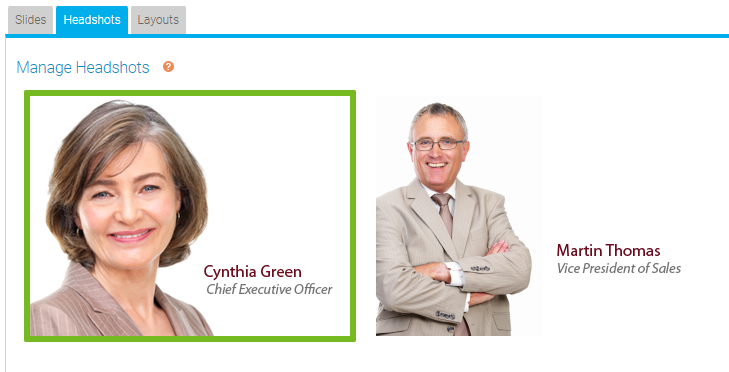
By default, the first headshot in your list is selected in Live Studio will be sent to your audience when the webcast is started. You can change the default order in the headshot list or select a different headshot in the Live Studio before clicking Start Webcast.
Any presenters with Live Studio access can advance headshots on the event.
On-Demand Event Controls
For on-demand events, available headshots will appear in the Headshots Library of the OD Studio.
Use the Headshots track of the Event Timeline to control what headshots appear and at what time they appear to viewers. Drag and drop headshots from the Library onto the Timeline to add them to the event.
Right-click on a headshot on the timeline to access additional controls. Click Edit Headshot to add a timecode for when the headshot should appear. Click Remove Headshot to remove it from the event.
Best Practices
- Headshots must be exactly 320 x 240 pixels in size. Larger images can be resized if needed.
- Headshots must be in .jpg or .png format.
Add content download or external links
Use the Event Resources option to share supplemental files or links with your audience. This is commonly used to add files such as PDFs, Word documents, Excel spreadsheets, PowerPoint decks, and more.
Setup
To upload a file, click Upload New Resource. Click Choose File to select the file and use the Document Title field to enter a name that will be visible to your audience. To allow the file to be shared outside the event, select Make Shareable.
By default, files uploaded as Event Resources are only accessible to viewer from within the webcast player. If a file is set to Make Shareable, click Edit Access to access a URL for the uploaded file, which can be used to share that Event Resources outside of the webcast player.
To include a link for viewers to access in the Event Resources, click Add External Link. In the URL field, enter the link to share with your audience. In the Title field, enter a name that will be visible to your audience. Note: A secure https URL is required.
If you broadcast your event by phone, select Enable MP3 Download to allow the audience to download the event audio.
Once uploaded, you can rename, reorder, and remove Event Resources. To update the file sharing settings, click Edit Access.
Accessing Event Resources
Event Resources are accessible to viewers under the the Event Resources tab of the webcast player, which is located below the video or headshot window for the event.
Presenter will not be able to view or access the Event Resources in the Live Studio.
Best Practices
- Each file can be up to 500 MB.
- Supported file types include: BMP, CSV, DOC, DOCX, DOT, DOTX, GIF, HTM, HTML, JPEG, JPG, MP3, PDF, PNG, PPT, PPTX, POTX, PPS, PPSX, RTF, SLDX, TXT, XLS, XLSX, XLTX.
